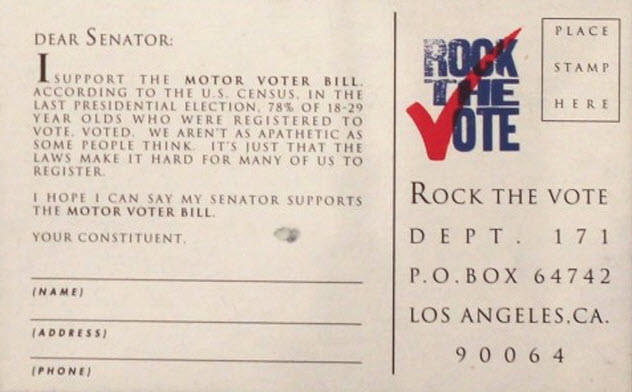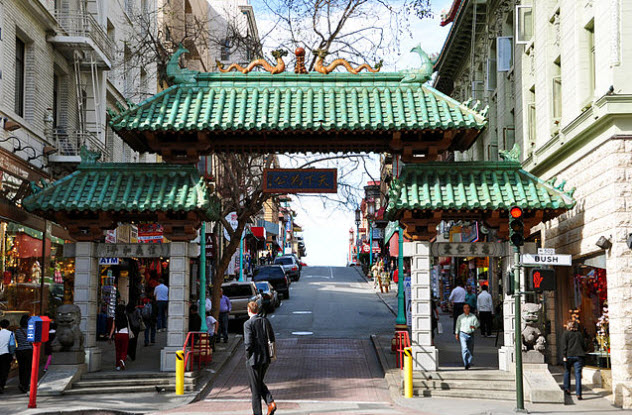 Humans
Humans  Humans
Humans  Animals
Animals 10 Animals That Humiliated and Harmed Historical Leaders
 History
History 10 Most Influential Protests in Modern History
 Creepy
Creepy 10 More Representations of Death from Myth, Legend, and Folktale
 Technology
Technology 10 Scientific Breakthroughs of 2025 That’ll Change Everything
 Our World
Our World 10 Ways Icelandic Culture Makes Other Countries Look Boring
 Misconceptions
Misconceptions 10 Common Misconceptions About the Victorian Era
 Mysteries
Mysteries 10 Strange Unexplained Mysteries of 2025
 Miscellaneous
Miscellaneous 10 of History’s Most Bell-Ringing Finishing Moves
 History
History 10 Great Escapes That Ended Right Back in Captivity
 Humans
Humans 10 Everyday Human Behaviors That Are Actually Survival Instincts
 Animals
Animals 10 Animals That Humiliated and Harmed Historical Leaders
 History
History 10 Most Influential Protests in Modern History
Who's Behind Listverse?

Jamie Frater
Head Editor
Jamie founded Listverse due to an insatiable desire to share fascinating, obscure, and bizarre facts. He has been a guest speaker on numerous national radio and television stations and is a five time published author.
More About Us Creepy
Creepy 10 More Representations of Death from Myth, Legend, and Folktale
 Technology
Technology 10 Scientific Breakthroughs of 2025 That’ll Change Everything
 Our World
Our World 10 Ways Icelandic Culture Makes Other Countries Look Boring
 Misconceptions
Misconceptions 10 Common Misconceptions About the Victorian Era
 Mysteries
Mysteries 10 Strange Unexplained Mysteries of 2025
 Miscellaneous
Miscellaneous 10 of History’s Most Bell-Ringing Finishing Moves
 History
History 10 Great Escapes That Ended Right Back in Captivity
10 Bizarre Tales Of Design That Created Our World Today
Hosted by Roman Mars, 99% Invisible is a show about design, architecture, and invention. Behind every blueprint, there’s an amazing story about wild dreams and crazy schemes. The show explores what drives people to make new things and how those inventions impact the world.
10‘Billy Possum’
Back in 1902, Theodore Roosevelt was hunting in Mississippi. Eventually, his guide found a black bear, bashed her over the head, and tied her to a tree for Roosevelt to shoot. But when Roosevelt saw the pitiful creature, he couldn’t pull the trigger.
The bear was so scrawny and pathetic that Roosevelt had one of his buddies slit the animal’s throat. But that part of the story never really got around. Instead, everyone heard about how Roosevelt took pity on a poor forest creature. The myth was popularized by a political cartoon that depicts an adorable bear. From there, somebody was inspired to turn Teddy’s bear into the iconic toy we all know today.
But the teddy bear wasn’t the only animal doll of the early 20th century. In this episode of 99% Invisible, Roman Mars and writer Jon Mooallem team up to tell the story of the Billy Possum—a toy that failed to win the hearts and minds of America’s children.
After the success of the teddy bear, toy makers were desperate to cash in on the next stuffed animal craze. They also wanted to associate their new doll with a US president, so the obvious choice was president-elect William Howard Taft. In 1909, the Atlanta Chamber of Commerce threw the big-bellied politician a swell ol’ party, complete with a true Southern dish.
The entree was possum and taters—basically, a roasted opossum atop a pile of sweet potatoes. As Taft was polishing his plate, the people of Atlanta surprised him with his own stuffed opossum doll. They nicknamed the toy “Billy Possum,” and everyone just knew this little guy was going to take the nation by storm.
In fact, people printed up Billy Possum postcards and made Billy Possum pins. Someone even wrote a catchy tune about the critter. But despite all the PR, the toy was a flop. As Billy Possum played dead, the teddy bear reigned supreme.
So why did one stuffed animal win and one fail? Well, as Jon Mooallem points out, it’s all about the origin story. Roosevelt showed the bear sympathy, and the story inspired a nation. As for Taft, he ate a lot of possum meat. It just doesn’t have quite the same emotional pull. Plus, there’s another good reason why people shunned Taft’s toy. As host Roman Mars points out, “Opossums are ugly, and nobody likes them.”
9‘Longbox’

In 1985, Tipper Gore formed the Parents Music Resource Center, a committee that was big into music censorship. They’re the group responsible for those black-and-white parental advisory stickers. Thanks to their efforts, groups across the country started censoring music. One judge went so far as to ban particular hip-hop artists from performing in his jurisdiction.
This bullying didn’t sit well with the music industry, especially with Virgin Records executive Jeff Ayeroff. He believed that politicians had power over music because young people didn’t vote. So Ayeroff launched Rock the Vote, an organization that would give power to young people and challenge pro-censorship politicians.
Jeff Gold of Warner Bros. was also a member of Rock the Vote, but he had another problem. When CDs were first released, music stores didn’t have the appropriate stands to display them. So the music industry created the longbox, a cardboard container that held the CD and jewel case inside, making it easier to store in shops used to selling LPs. However, once you bought the CD, you tossed the longbox into the trash. Many musicians found this wasteful and environmentally harmful.
One of those bands was REM, who didn’t want their album Out of Time released inside a longbox. But according to 99% Invisible producer Whitney Jones, Ayeroff and Gold came up with an ingenious scheme that made Out of Time “the most politically important album in the history of the US.” In “Longbox,” Jones discusses with Roman Mars how it altered the American electoral landscape.
The idea was simple. There would be a petition on the back of each longbox supporting the upcoming Motor Voter Act, a piece of legislation that would make it easier for kids to vote by allowing them to register at the DMV. When fans purchased Out of Time, they simply cut off the back, signed their name, and sent the petition to their Congressperson.
REM loved the plan. In March 1991, Congressional offices were bombarded with cardboard petitions. Politicians took note, and the Motor Voter Act was passed. True, George H.W. Bush vetoed the bill. But when Bill Clinton was elected, he signed it into law.
Since then, over 150 million people have registered to vote at the DMV, thanks to REM. It’s kind of ironic because Al Gore was Clinton’s running mate and husband to Tipper, the woman who started it all.
8‘Clean Trains’
Back in the day, New York City was synonymous with “graffiti-covered subways” in which trains broke down constantly. In 1981 alone, there were 1,800 subway car fires. This happened because the Metropolitan Transport Authority (MTA) was forced to cut its budget.
Foolishly, they scaled back on necessities like mechanics and regular inspections. Throw teenage gangs into the mix, and it’s no wonder that some described this subterranean zone as a “Dantean hellscape.”
In the 1970s, New York politicians believed that if they removed this graffiti, it would send a strong message to the people of New York. One mayor built razor wire fences around the trains and brought in vicious guard dogs. However, the vandals simply cut their way through and gave the dogs treats.
Another plan involved painting all the trains white to cover up the graffiti. Of course, this simply gave artists a clean slate. Soon, the so-called “Great White Fleet” was covered in fresh tags.
Desperate, New York turned to David Gunn, the Wyatt Earp of the transit world. He had tamed wild and woolly subway systems across the country. But even Gunn was reluctant to take on New York, the Tombstone of transportation. He thought it was a “suicide mission.” Luckily, his mom talked him into taking the job.
In “Clean Trains,” reporter Ann Heppermann and the omnipresent Roman Mars examine how Gunn launched the Clean Train Program, a system that had zero tolerance for graffiti. If vandals bombed a train car, it was taken off the line immediately, even during rush hour. The train was only returned to service once the graffiti was removed. Gunn also convinced the city to give the MTA more money for mechanics and managers, who repaired the rickety cars.
Thanks to Gunn’s policies, the Big Apple officially beat graffiti for good on May 12, 1989. Of course, the Clean Train Program has turned NYC subways into the Holy Grail for graffiti artists. Today, if you bomb a car, you could face jail time and hefty fines. But marking an NYC train is such a big deal that many people travel to the city from all over the world, willing to risk the punishment. Once authorities spot the graffiti, they pull the car off the line, so no one can admire the artist’s work.
But hey, that’s what Instagram is for.
7‘Pagodas And Dragon Gates’

At one time, San Franscisco’s Chinatown looked exactly like the rest of San Francisco: old brick buildings without any fantastical flares. So what inspired the Chinese to turn their neighborhood into an Asian wonderland?
According to 99% Invisible, it was all about self-preservation. In the early 1900s, Chinese immigrants faced an incredible amount of persecution, which is how Chinatown was created.
When white people vacated their old homes, the Chinese moved in. But once the immigrants settled into this neighborhood, the white people wouldn’t let them leave. So in a way, Chinatown was like a prison. But it was also a sanctuary. If the Chinese stayed in their neighborhood, they were relatively safe.
That all changed in 1906 when a 7.8-magnitude earthquake sparked a massive fire that burned Chinatown to the ground. With Chinatown located on prime real estate and the old buildings gone, city planners wanted to move the immigrants to the outskirts of town, next to the slaughterhouses.
But the Chinese fought back. Since San Francisco was a key port for American-Chinese trade, several local Chinese business leaders threatened to move to a separate city if they were kicked out of their neighborhood. So government officials allowed the Chinese to stay put.
Architect Look Tin Eli was hired to reshape the neighborhood. But instead of building Victorian-style houses like before, he added unique Asian flourishes. He stuck pagodas on top of buildings and added Chinese creatures to give the structures an Eastern feel.
Of course, this new architecture was about as Chinese as a fortune cookie. It was all just for show. For years, Chinese immigrants were despised for their “foreignness.” There were rumors that they lived underground, and many people believed that Chinatown was a hotbed of opium and prostitution.
Knowing that white San Franciscans would continue to view their Chinese neighbors as different and strange, Look Tin Eli decided to play up the neighborhood’s “Asian-ness” but in a sanitized, Western-friendly way. He created an amusement park look to disarm white people and win them over. In a way, it worked.
Tourists and money started flowing into Chinatown, and many newspapers published positive stories about the immigrant community. That’s not to say that Chinatown defeated racism, but it did give the Chinese community an extra layer of protection in a strange new land.
6‘Awareness’
When people think of the 1980s, they remember Reaganomics, Rubik’s Cubes, and really wretched fashion. Tragically, they also remember the arrival of HIV/AIDS. True, more people are suffering from this disease today. But in the early ’80s, there was no public conversation and no big push for research. In the meantime, people were scared and dying.
But that all changed thanks to some artists armed with scissors and red ribbons.
In “Awareness,” producer Audrey Quinn tells the story of Visual AIDS, an artist collective based in New York. The members all had friends suffering from AIDS. Since no one was discussing this epidemic, they decided to start the ball rolling. They began incorporating the theme of HIV/AIDS into their work, but their biggest PR coup came in the form of a looping red ribbon (aka the AIDS awareness ribbon).
Inspired by the yellow ribbon that comes during wartime, the artists chose the color red to symbolize blood. They began passing out these ribbons on the street, free of charge. However, things really went up a notch at the 1991 Tony Awards. The artists convinced famous fashion designers to adorn their clients’ clothes with the red ribbons. All evening long, stars like Jeremy Irons and Kevin Spacey came onstage sporting the pins on their lapels.
However, the actors weren’t allowed to explain why they were wearing these ribbons. The network actually threatened to cut to commercial if anyone talked about AIDS. But the secrecy backfired. Soon, everyone was interested in these bloodred ribbons. They started popping up on celebrity chests at the Emmys, the Grammys, and the Oscars. In no time, people across the country—from New York socialites to small church groups—were making and wearing their own ribbons in support of AIDS victims.
In fact, the ribbon became such a phenomenon that The New York Times declared 1991 “The Year of the Ribbon.” Thanks to Visual AIDS and their hard work, the US government passed new AIDS legislation and started funding HIV research.
Since the AIDS awareness ribbons hit the street, numerous other charities have followed suit. That’s why there are hundreds of colorful, looped ribbons everywhere you look, raising awareness for every issue imaginable, from breast cancer to bullying.
5‘Monumental Dilemma’
Monuments are tricky things. These larger-than-life statues are meant to honor great men and women. But what if those people weren’t so great? What if the monument is dedicated to someone kind of awful? Should the statue be preserved since it’s part of history? Or should it be abandoned or torn down?
Perhaps no other monument represents this conundrum like the Hannah Duston statue. Located on an island in Boscawen, New Hampshire, this 9-meter-tall (30 ft) statue depicts a colonial woman with a tomahawk in one hand and scalps in the other. As 99% Invisible producer Jack Rodolico explains, there’s a troubled story behind those granite war trophies.
In 1697, Hannah Duston, her baby daughter, and her nursemaid were kidnapped by Abenaki Native Americans. According to Duston, one of the Abenaki warriors smashed her baby to death against a tree. Eventually, the war party gave Duston and the maid to another group of Native Americans living on a river island in what is now Boscawen. Only instead of warriors, this bunch was mainly made up of women and children.
That night, Duston made her escape. After waking her maid and another white captive, Duston killed 10 of the sleeping Abenaki before taking their scalps. Two of her victims were mothers, and six were children. With her bloodlust sated, Duston stole a canoe, and the group returned to their colony. Days later, Duston and her husband sold the scalps for cash in Boston.
Duston’s story spread across the US, and she became a colonial rock star. But like all celebrities, her star began to fade—until she was rediscovered in the early 1800s. This was the era of Manifest Destiny, and writers were inspired by Duston’s story.
Soon, she was showing up in everything from schoolbooks to children’s books to the works of Henry David Thoreau. Of course, the writers usually glossed over the fact that she’d butchered children. Instead, the kids were turned into warriors.
In 1874, Duston received her own monument, which is also the oldest monument in the US dedicated to a woman. In recent years, there has been a bit of debate about the statue. In fact, as producer Jack Rodolico discovered, no one is even taking care of the statue. Should people just let the statue waste away because of its contentious past? Or should it be restored because it’s the first monument to an American woman?
4‘Holdout’
The Oscar-winning film Up tells the story of Carl Fredricksen, an elderly grump who finds himself living in the middle of a construction site. Fortunately for Carl, he can just hitch his house to a bunch of balloons and float away on a grand adventure. Of course, not everyone has that luxury.
In “Holdout,” Roman Mars and producer Katie Mingle tell the similar real-life story of Edith Macefield, an old woman who wouldn’t get out of the way when land developers wanted to build a shopping mall in the Seattle neighborhood of Ballard in 2006.
Macefield had lived in Ballard for around 50 years, and she wasn’t about to move just because some whippersnapper with a thick wallet wanted to build a shopping center. Even when the developers offered $1 million for her $120,000 house and payment of all her health bills, Macefield said no.
After all, she was knocking on 90 and didn’t have any kids. What was she going to do with a million bucks? So Macefield stayed put, and the land developers built a gargantuan shopping mall around three sides of her house.
If she looked out the window, there was a brick wall. She could almost reach out and touch it. But despite the inconvenience, she hunkered down and stayed true to her cranky self. If curious reporters showed up, she told them to get lost. However, there was one person whom Macefield liked: Barry Martin, the superintendent in charge of construction.
Even though he was in charge of building the shopping mall, Martin befriended Macefield and began taking care of her. He took her to hair appointments, cooked all her meals, and dropped by on the weekends to watch movies with the 86-year-old. He became her caregiver and confidante. During their conversations, he learned how she’d allegedly served as a World War II spy, played the saxophone with Tommy Dorsey, and was related to the legendary Benny Goodman.
Martin took care of Macefield for nearly two years. When she died in 2008, she left her house to Martin. He sold it to an investor, but nothing has happened to the house as of early 2016. There has been talk of tearing it down, but Martin says that Macefield wouldn’t mind. She didn’t care what happened to the house after she was gone. But while she was alive, she wasn’t going anywhere.
3‘There Is A Light That Never Goes Out’
If you ever visit Livermore, California, you might want to drop by Fire Station #6. So why is this garage a must-stop tourist spot? Well, because of the lightbulb, of course. After all, this thing has been glowing since 1901.
In “There Is a Light That Never Goes Out,” writer Jon Mooallem sheds a little light on the so-called Centennial Lightbulb, a wondrous piece of glass created by Adolphe Chaillet. A businessman and inventor, Chaillet traveled across the country, showing off his superior lightbulbs to interested customers.
Somehow, one of his bulbs ended up in the hands of a Livermore shop owner who donated the device to the local fire station. This was a big deal back in 1901, as it allowed firefighters to move around quickly in the middle of the night. Five years later, when the firefighters moved into a new building, they took along their lone lightbulb.
Over 113 years later, the bulb is still going strong. True, it’s blinked out on a few occasions due to power failures or because it was moved from one station to another. But the bulb itself is still in pretty good condition.
Nobody really knows why. Some theorize that it’s because this particular type of bulb uses carbon filaments instead of tungsten. Plus, the filaments are eight times thicker than normal. But even then, that doesn’t explain the bulb’s longevity. Nevertheless, the Centennial Lightbulb has continued shining through every major worldwide event of the past century, proving that they really don’t make ’em like they used to.
2‘Vulcanite Dentures’

Most 99% Invisible episodes are about design and invention that make the world a better place. But in “Vulcanite Dentures,” Roman Mars takes us back to the 19th century when an angry dentist made a rash decision.
To set the scene, we need to talk about dentures. Once upon a time, fake teeth were only for the rich and powerful because they were made of gold or ivory. But when vulcanite hard rubber hit the market, it revolutionized the industry. Vulcanite was so cheap that anyone could own a pair of prosthetic pearly whites.
Then Josiah Bacon showed up.
Bacon worked for the Goodyear Dental Vulcanite Company. In 1864, they acquired the patent for vulcanite. However, it wasn’t exactly legitimate. In the 1850s, a hack named Dr. John Cummings applied for a vulcanite patent even though he didn’t invent it. He was rejected three times before he was finally granted his wish in 1864. Then Cummings gave his patent to the Vulcanite Company. Thanks to some backroom finagling, Bacon was set to receive all money related to the new patent.
Suddenly, ordinary dentists using vulcanite dentures were charged annual fees and hefty royalties—which Bacon picked up personally. The man traveled across the US, prosecuting dentists and collecting cash. If they wanted to use vulcanite, they had to make Bacon happy. And that’s where Samuel Chalfant enters our story.
Chalfant was a dentist who refused to pay the exorbitant fees, so he took off running. Infuriated, Bacon chased him across the country before catching up with him in San Francisco in 1879. Defeated, Chalfant allegedly went to Bacon’s hotel to beg for forgiveness. He took along a pistol, and during their heated conversation, Chalfant claimed the gun accidentally went off. Regardless of Chalfant’s intention, no doctor could save Josiah’s bacon.
Chalfant was sentenced to 10 years in San Quentin, although he only served six. Once, he even broke out of jail, but he was picked up by authorities when his false beard fell off. However, thanks to his bloody deed, the Vulcanite Company decided it was probably too risky to send more agents after wayward dentists. They allowed the patent to lapse. Dentists were once again free to use vulcanite, all thanks to Samuel Chalfant and his murderous tendencies.
1‘Worst Smell In The World’

At first whiff, Liquid ASS doesn’t seem like a noble creation. Invented by prankster Allen Wittman, it comes in a little spray bottle and smells exactly like you’d imagine from the name.
Needless to say, Wittman’s invention was a hit with teenagers and shock jocks like Howard Stern. But as fate would have it, Liquid ASS eventually rose above its immature origins to save lives.
In “Worst Smell in the World,” Roman Mars and Amy Standen explore how Liquid ASS became an integral part of military training—thanks to Stu Segall, a 1990s TV producer of shows like Hunter and Renegade. After 9/11, networks wanted to scale back on the violent content. Suddenly, Segall was out of a job, and his sets were wasting away.
That’s when Segall came up with a bright idea. What if he used his sets to help train soldiers? Particularly, what if he used all his skills to create a fake Iraqi market? That way, young troops could experience what it was really like to be in a foreign country. Segall erected prayer towers, hired Iraqi actors, and set up stalls full of fake vegetables. As soldiers wandered about the revamped television sets, Segall would play the sounds of gunfire, explosions, and even scenes from Saving Private Ryan.
All this hands-on training helped prepare soldiers for the reality of war. But Segall wasn’t just helping combat troops. He also wanted medics to gain real-world experience. That’s why Stu put a few actors inside Cut Suits. Similar to fatsuits, these full-body prosthetics allowed medics in training to practice making incisions on a “real” victim. Intestines even hung out of fake stomach cavities, which is where Liquid ASS returns to our story.
As part of their training, medics would often operate on these fake entrails. As they sewed up the guts, Segall and his crew would often release the smell of Liquid ASS because the worst thing that could happen was for the organ to tear open. Fecal matter would spill into the body, and that’s incredibly dangerous. It also makes field surgeries even more difficult, especially when there are bombs going off everywhere.
Liquid ASS helps medics get used to the realities of actual combat. So when they’re in the field and get a whiff of a real problem, they’ll be able to fall back on their days of working with the world’s worst gag gift.
Nolan Moore is a freelance writer and editor from Texas. If you want, you can friend/follow him on Facebook or send him an email.








